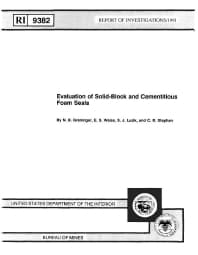Mining Publication: Evaluation of Solid-Block and Cementitious Foam Seals
Original creation date: January 1991
Authors: NB Greninger, ES Weiss, SJ Luzik, CR Stephan
NIOSHTIC2 Number: 10011048
Pittsburgh, PA: U.S. Department of the Interior, Bureau of Mines, RI 9382, 1991 Jan; :1-13
The U.S. Bureau of Mines conducted explosion tests on various full- scale cementitious bulkheads used in abandoned mine areas to evaluate the ability of the bulkheads to withstand gas explosion overpressures of 20 psig. Tests were performed on 120-ft2 solid- concrete-block seals of varying thicknesses and designs. Of the seven solid-concrete-block seals tested, only the standard-type seal, having a 16-in thickness, keyed at the floor and ribs, all joints mortared, wedged at the roof, and a center pilaster, maintained its integrity when subjected to a 20-psig pressure wave. After being subjected to repeated explosions, the standard seal only showed a small hairline crack and had an air leakage of 87 ft3/min at a pressure differential of 1 in h2o. Tests were performed on cementitious foam seals of varying thicknesses and compressive strengths. Explosion tests have shown that 200-psi strength, 4- and 8-ft-thick seals can withstand a 20-psig pressure wave. At a pressure differential of 1 in h2o, no air leakage was detected through the 200-psi, 8-ft-thick foam seal.

NIOSHTIC2 Number: 10011048
Pittsburgh, PA: U.S. Department of the Interior, Bureau of Mines, RI 9382, 1991 Jan; :1-13